CADILLAC XLR 2009 1.G Owners Manual
Manufacturer: CADILLAC, Model Year: 2009, Model line: XLR, Model: CADILLAC XLR 2009 1.GPages: 462, PDF Size: 3.72 MB
Page 1 of 462
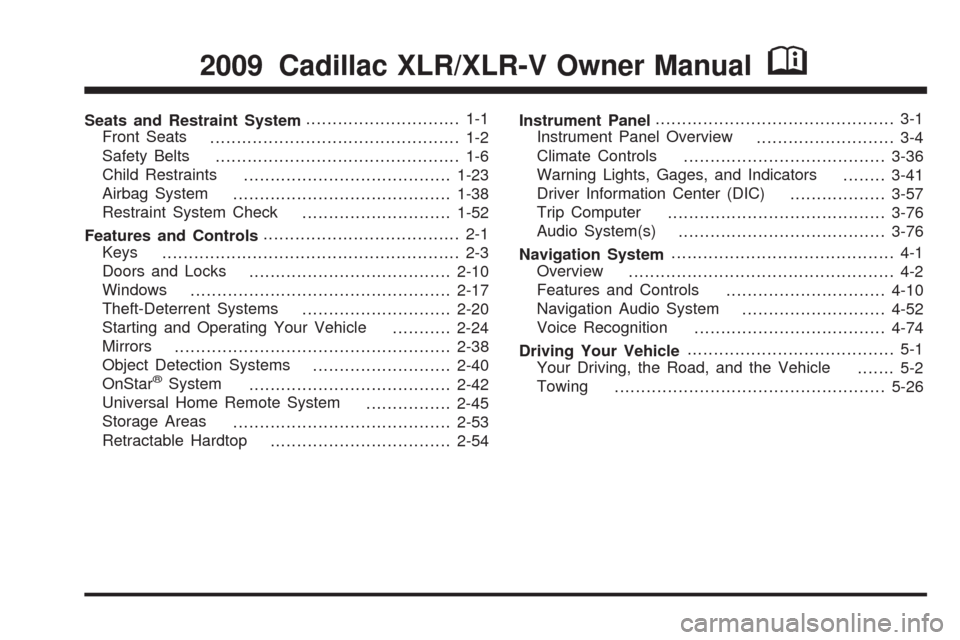
Seats and Restraint System............................. 1-1
Front Seats
............................................... 1-2
Safety Belts
.............................................. 1-6
Child Restraints
.......................................1-23
Airbag System
.........................................1-38
Restraint System Check
............................1-52
Features and Controls..................................... 2-1
Keys
........................................................ 2-3
Doors and Locks
......................................2-10
Windows
.................................................2-17
Theft-Deterrent Systems
............................2-20
Starting and Operating Your Vehicle
...........2-24
Mirrors
....................................................2-38
Object Detection Systems
..........................2-40
OnStar
®System
......................................2-42
Universal Home Remote System
................2-45
Storage Areas
.........................................2-53
Retractable Hardtop
..................................2-54Instrument Panel............................................. 3-1
Instrument Panel Overview
.......................... 3-4
Climate Controls
......................................3-36
Warning Lights, Gages, and Indicators
........3-41
Driver Information Center (DIC)
..................3-57
Trip Computer
.........................................3-76
Audio System(s)
.......................................3-76
Navigation System.......................................... 4-1
Overview
.................................................. 4-2
Features and Controls
..............................4-10
Navigation Audio System
...........................4-52
Voice Recognition
....................................4-74
Driving Your Vehicle....................................... 5-1
Your Driving, the Road, and the Vehicle
....... 5-2
Towing
...................................................5-26
2009 Cadillac XLR/XLR-V Owner ManualM
Page 2 of 462

Service and Appearance Care.......................... 6-1
Service
..................................................... 6-3
Fuel
......................................................... 6-5
Checking Things Under the Hood
...............6-10
Rear Axle
...............................................6-41
Headlamp Aiming
.....................................6-42
Bulb Replacement
....................................6-45
Windshield Replacement
...........................6-45
Windshield Wiper Blade Replacement
.........6-45
Tires
......................................................6-46
Appearance Care
.....................................6-74Vehicle Identi�cation
.................................6-81
Electrical System
......................................6-82
Capacities and Speci�cations
.....................6-90
Maintenance Schedule..................................... 7-1
Maintenance Schedule
................................ 7-2
Customer Assistance Information.................... 8-1
Customer Assistance and Information
........... 8-2
Reporting Safety Defects
...........................8-14
Vehicle Data Recording and Privacy
...........8-16
Index................................................................ 1
Page 3 of 462

GENERAL MOTORS, GM, the GM Emblem, CADILLAC,
the CADILLAC Crest & Wreath, and the name XLR
are registered trademarks, and the name XLR-V
is a trademark of General Motors Corporation.
This manual includes the latest information at the time it
was printed. GM reserves the right to make changes
after that time without notice. For vehicles �rst sold
in Canada, substitute the name “General Motors
of Canada Limited” for Cadillac Motor Car Division
wherever it appears in this manual.
This manual describes features that may or may not be
on your speci�c vehicle.
Read this manual from beginning to end to learn about
the vehicle’s features and controls. Pictures, symbols,
and words work together to explain vehicle operation.
Keep this manual in the vehicle for quick reference.
Canadian Owners
A French language copy of this manual can be obtained
from your dealer/retailer or from:
Helm, Incorporated
P.O. Box 07130
Detroit, MI 48207
1-800-551-4123
helminc.com
Propriétaires Canadiens
On peut obtenir un exemplaire de ce guide en français
auprès de concessionnaire ou à l’adresse suivante:
Helm Incorporated
P.O. Box 07130
Detroit, MI 48207
1-800-551-4123
helminc.com
Index
To quickly locate information about the vehicle use the
Index in the back of the manual. It is an alphabetical
list of what is in the manual and the page number where
it can be found.
Litho in U.S.A.
Part No. 25789008 A First Printing
©2008 General Motors Corporation. All Rights Reserved.
iii
Page 4 of 462
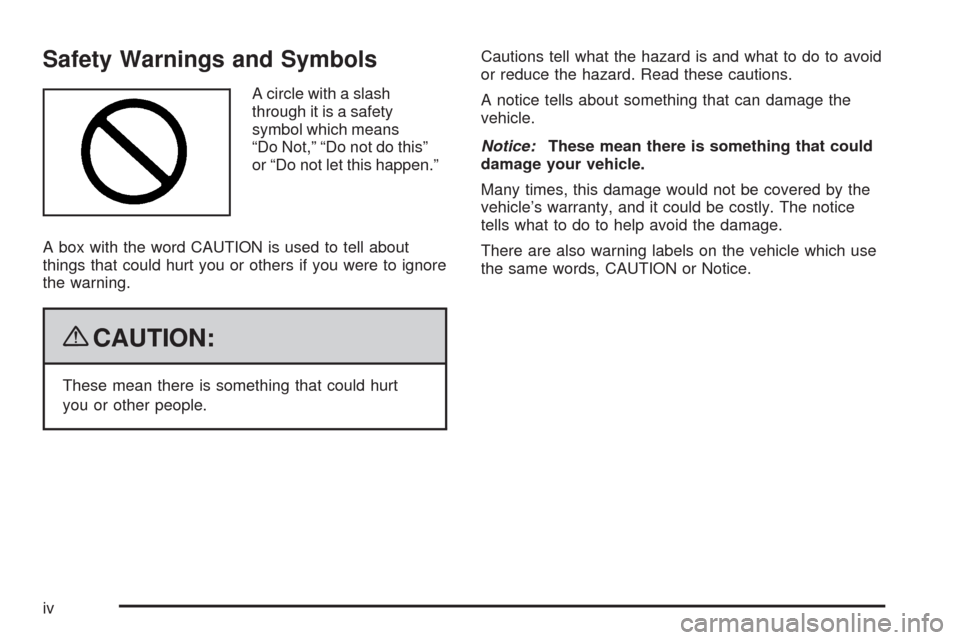
Safety Warnings and Symbols
A circle with a slash
through it is a safety
symbol which means
“Do Not,” “Do not do this”
or “Do not let this happen.”
A box with the word CAUTION is used to tell about
things that could hurt you or others if you were to ignore
the warning.
{CAUTION:
These mean there is something that could hurt
you or other people.Cautions tell what the hazard is and what to do to avoid
or reduce the hazard. Read these cautions.
A notice tells about something that can damage the
vehicle.
Notice:These mean there is something that could
damage your vehicle.
Many times, this damage would not be covered by the
vehicle’s warranty, and it could be costly. The notice
tells what to do to help avoid the damage.
There are also warning labels on the vehicle which use
the same words, CAUTION or Notice.
iv
Page 5 of 462
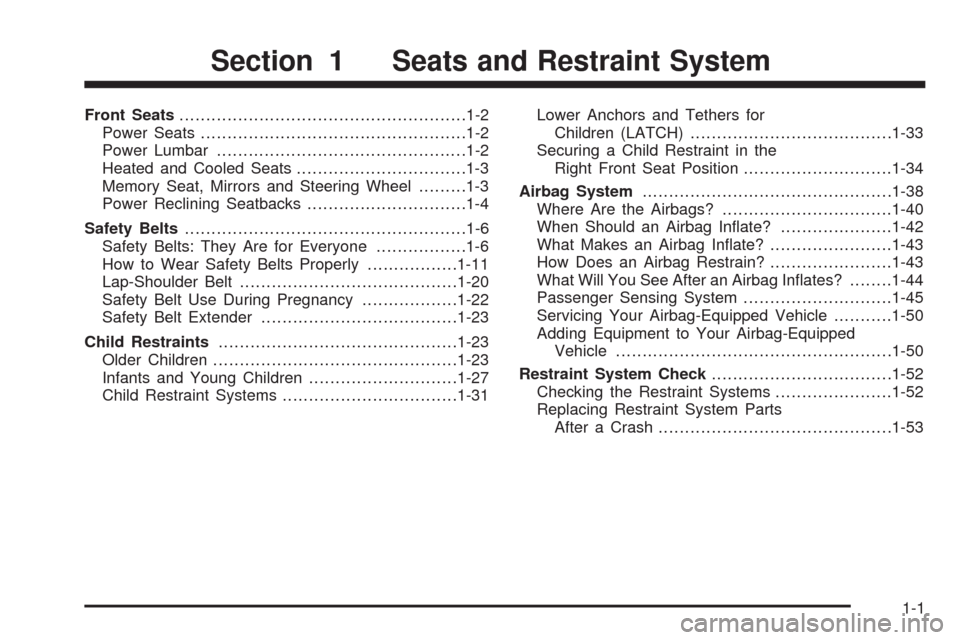
Front Seats......................................................1-2
Power Seats..................................................1-2
Power Lumbar ...............................................1-2
Heated and Cooled Seats................................1-3
Memory Seat, Mirrors and Steering Wheel.........1-3
Power Reclining Seatbacks..............................1-4
Safety Belts.....................................................1-6
Safety Belts: They Are for Everyone.................1-6
How to Wear Safety Belts Properly.................1-11
Lap-Shoulder Belt.........................................1-20
Safety Belt Use During Pregnancy..................1-22
Safety Belt Extender.....................................1-23
Child Restraints.............................................1-23
Older Children..............................................1-23
Infants and Young Children............................1-27
Child Restraint Systems.................................1-31Lower Anchors and Tethers for
Children (LATCH)......................................1-33
Securing a Child Restraint in the
Right Front Seat Position............................1-34
Airbag System...............................................1-38
Where Are the Airbags?................................1-40
When Should an Airbag In�ate?.....................1-42
What Makes an Airbag In�ate?.......................1-43
How Does an Airbag Restrain?.......................1-43
What Will You See After an Airbag In�ates?........1-44
Passenger Sensing System............................1-45
Servicing Your Airbag-Equipped Vehicle...........1-50
Adding Equipment to Your Airbag-Equipped
Vehicle....................................................1-50
Restraint System Check..................................1-52
Checking the Restraint Systems......................1-52
Replacing Restraint System Parts
After a Crash............................................1-53
Section 1 Seats and Restraint System
1-1
Page 6 of 462
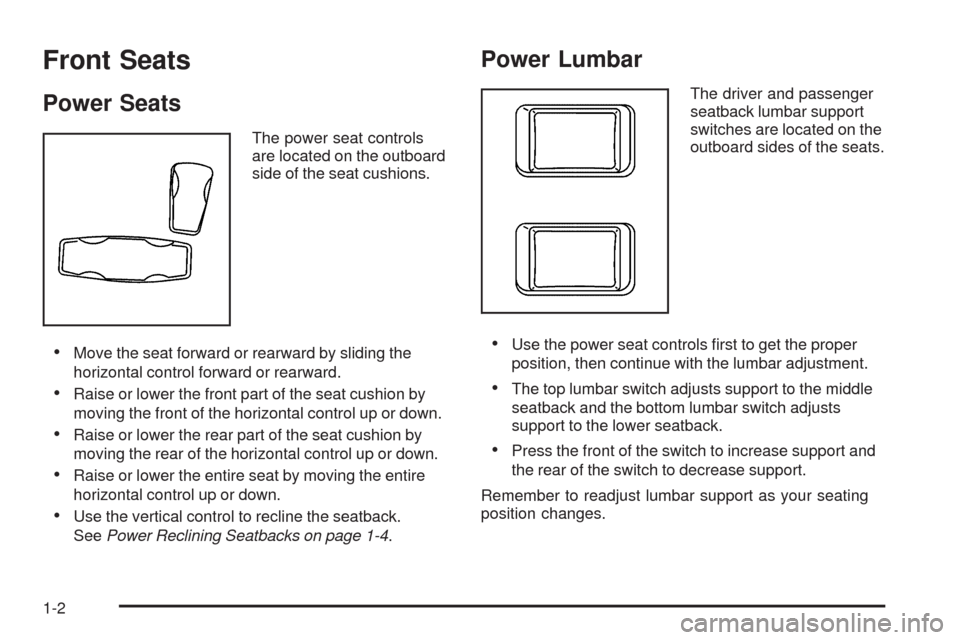
Front Seats
Power Seats
The power seat controls
are located on the outboard
side of the seat cushions.
Move the seat forward or rearward by sliding the
horizontal control forward or rearward.
Raise or lower the front part of the seat cushion by
moving the front of the horizontal control up or down.
Raise or lower the rear part of the seat cushion by
moving the rear of the horizontal control up or down.
Raise or lower the entire seat by moving the entire
horizontal control up or down.
Use the vertical control to recline the seatback.
SeePower Reclining Seatbacks on page 1-4.
Power Lumbar
The driver and passenger
seatback lumbar support
switches are located on the
outboard sides of the seats.
Use the power seat controls �rst to get the proper
position, then continue with the lumbar adjustment.
The top lumbar switch adjusts support to the middle
seatback and the bottom lumbar switch adjusts
support to the lower seatback.
Press the front of the switch to increase support and
the rear of the switch to decrease support.
Remember to readjust lumbar support as your seating
position changes.
1-2
Page 7 of 462
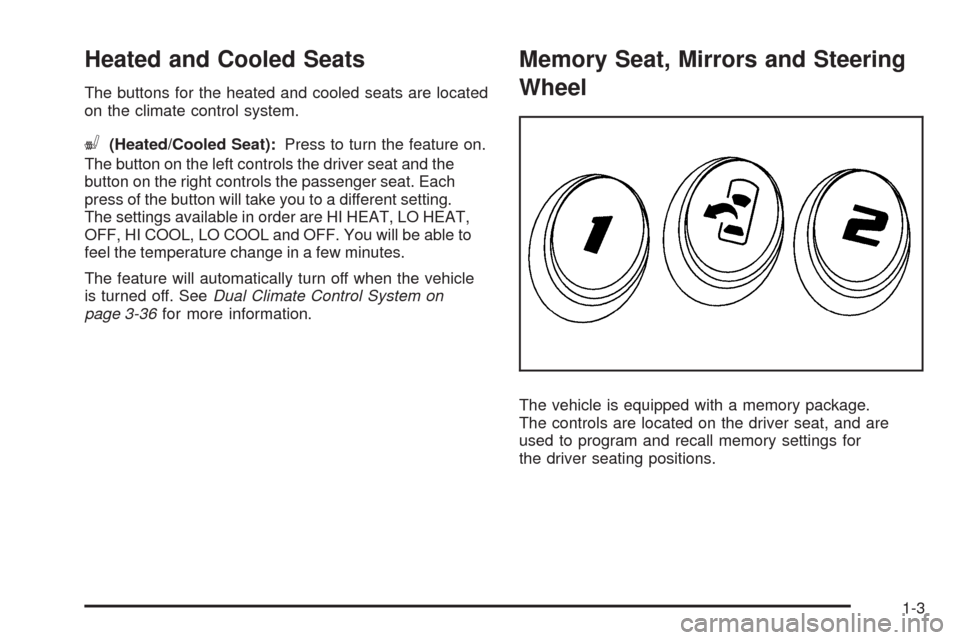
Heated and Cooled Seats
The buttons for the heated and cooled seats are located
on the climate control system.
((Heated/Cooled Seat):Press to turn the feature on.
The button on the left controls the driver seat and the
button on the right controls the passenger seat. Each
press of the button will take you to a different setting.
The settings available in order are HI HEAT, LO HEAT,
OFF, HI COOL, LO COOL and OFF. You will be able to
feel the temperature change in a few minutes.
The feature will automatically turn off when the vehicle
is turned off. SeeDual Climate Control System on
page 3-36for more information.
Memory Seat, Mirrors and Steering
Wheel
The vehicle is equipped with a memory package.
The controls are located on the driver seat, and are
used to program and recall memory settings for
the driver seating positions.
1-3
Page 8 of 462
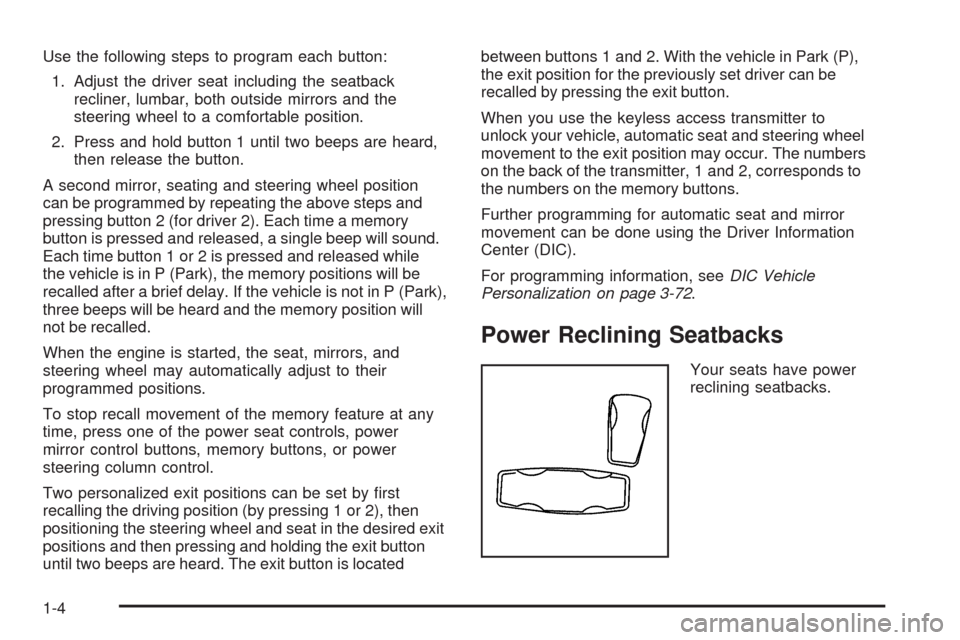
Use the following steps to program each button:
1. Adjust the driver seat including the seatback
recliner, lumbar, both outside mirrors and the
steering wheel to a comfortable position.
2. Press and hold button 1 until two beeps are heard,
then release the button.
A second mirror, seating and steering wheel position
can be programmed by repeating the above steps and
pressing button 2 (for driver 2). Each time a memory
button is pressed and released, a single beep will sound.
Each time button 1 or 2 is pressed and released while
the vehicle is in P (Park), the memory positions will be
recalled after a brief delay. If the vehicle is not in P (Park),
three beeps will be heard and the memory position will
not be recalled.
When the engine is started, the seat, mirrors, and
steering wheel may automatically adjust to their
programmed positions.
To stop recall movement of the memory feature at any
time, press one of the power seat controls, power
mirror control buttons, memory buttons, or power
steering column control.
Two personalized exit positions can be set by �rst
recalling the driving position (by pressing 1 or 2), then
positioning the steering wheel and seat in the desired exit
positions and then pressing and holding the exit button
until two beeps are heard. The exit button is locatedbetween buttons 1 and 2. With the vehicle in Park (P),
the exit position for the previously set driver can be
recalled by pressing the exit button.
When you use the keyless access transmitter to
unlock your vehicle, automatic seat and steering wheel
movement to the exit position may occur. The numbers
on the back of the transmitter, 1 and 2, corresponds to
the numbers on the memory buttons.
Further programming for automatic seat and mirror
movement can be done using the Driver Information
Center (DIC).
For programming information, seeDIC Vehicle
Personalization on page 3-72.
Power Reclining Seatbacks
Your seats have power
reclining seatbacks.
1-4
Page 9 of 462
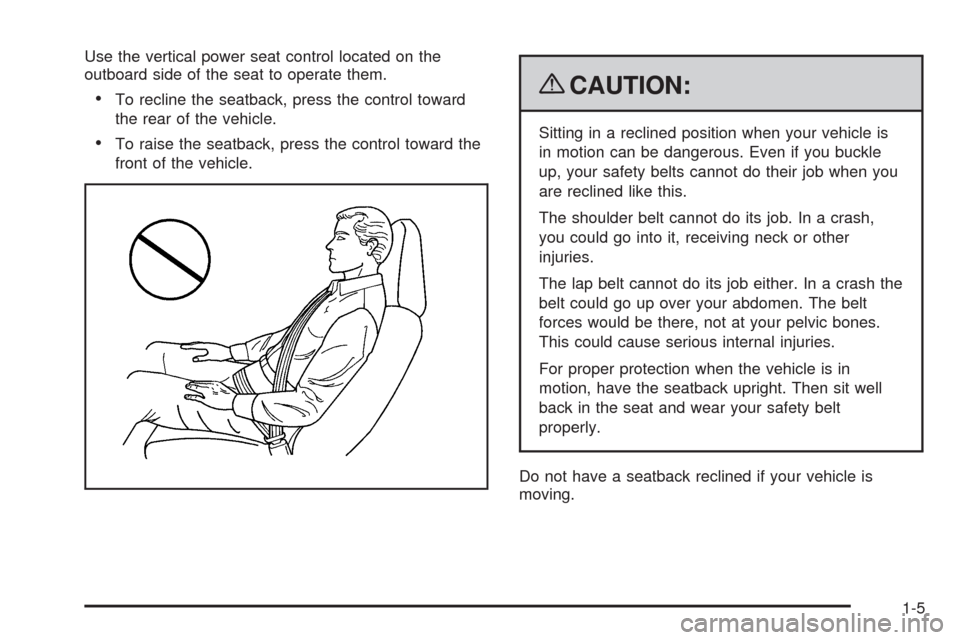
Use the vertical power seat control located on the
outboard side of the seat to operate them.
To recline the seatback, press the control toward
the rear of the vehicle.
To raise the seatback, press the control toward the
front of the vehicle.
{CAUTION:
Sitting in a reclined position when your vehicle is
in motion can be dangerous. Even if you buckle
up, your safety belts cannot do their job when you
are reclined like this.
The shoulder belt cannot do its job. In a crash,
you could go into it, receiving neck or other
injuries.
The lap belt cannot do its job either. In a crash the
belt could go up over your abdomen. The belt
forces would be there, not at your pelvic bones.
This could cause serious internal injuries.
For proper protection when the vehicle is in
motion, have the seatback upright. Then sit well
back in the seat and wear your safety belt
properly.
Do not have a seatback reclined if your vehicle is
moving.
1-5
Page 10 of 462
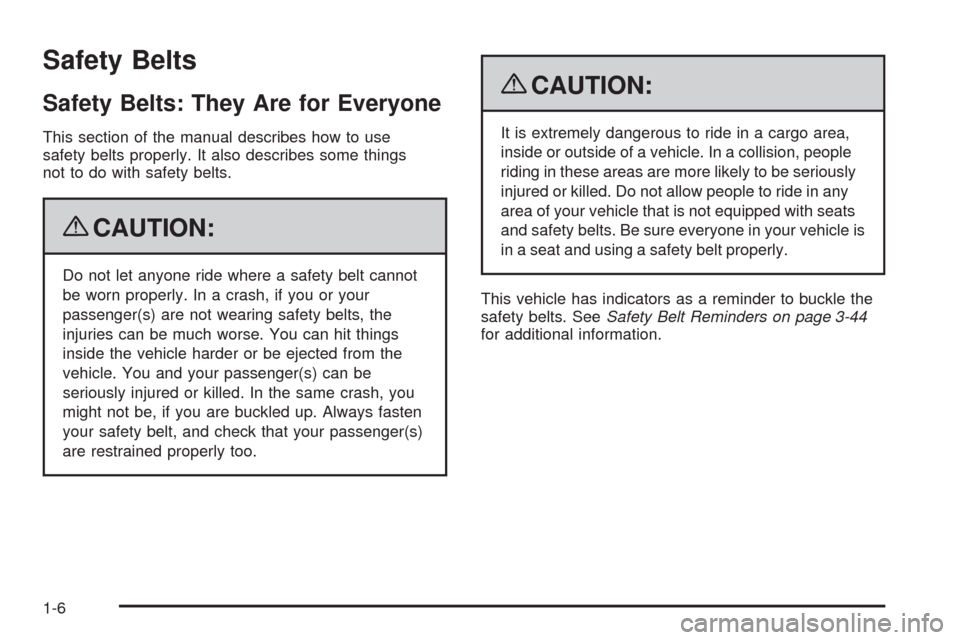
Safety Belts
Safety Belts: They Are for Everyone
This section of the manual describes how to use
safety belts properly. It also describes some things
not to do with safety belts.
{CAUTION:
Do not let anyone ride where a safety belt cannot
be worn properly. In a crash, if you or your
passenger(s) are not wearing safety belts, the
injuries can be much worse. You can hit things
inside the vehicle harder or be ejected from the
vehicle. You and your passenger(s) can be
seriously injured or killed. In the same crash, you
might not be, if you are buckled up. Always fasten
your safety belt, and check that your passenger(s)
are restrained properly too.
{CAUTION:
It is extremely dangerous to ride in a cargo area,
inside or outside of a vehicle. In a collision, people
riding in these areas are more likely to be seriously
injured or killed. Do not allow people to ride in any
area of your vehicle that is not equipped with seats
and safety belts. Be sure everyone in your vehicle is
in a seat and using a safety belt properly.
This vehicle has indicators as a reminder to buckle the
safety belts. SeeSafety Belt Reminders on page 3-44
for additional information.
1-6